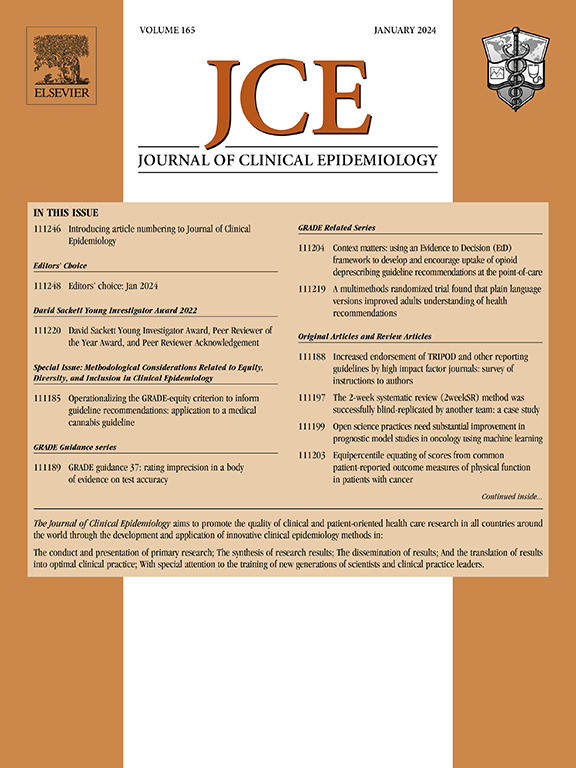使用已编纂的stop - start和Beers标准的潜在不适当处方的患病率和预测因素:安大略省老年人群的回顾性队列研究。
IF 5.2
2区 医学
Q1 HEALTH CARE SCIENCES & SERVICES
引用次数: 0
摘要
目的:量化潜在的不当处方(PIP),并使用先前编码的stop - start和Beers标准评估安大略省老年人群中患者特征与PIP之间的关系。研究设计和设置:2014年stop - start和2015年Beers标准适用于健康管理数据的既定子集被用于识别健康管理数据中的PIP实例。使用多变量逻辑回归检查患者特征与PIP之间的关联。使用安大略省的大型卫生管理数据库,其中包括个人层面的药物分配、医生服务使用、急诊室就诊、住院、死亡率和社会人口统计数据的相关信息,形成了一个队列,包括2003年4月至2017年3月期间至少开具过一次处方的所有≥65岁的患者(N= 2937927)。结果:在总共2,937,927例患者中,使用stop - start标准确定了2,220,641例(75.6%)患者至少有一种PIP。使用Beers标准,确定了1,505,243例(51.2%)患者。stop - start标准确定的最常见的PIP是65岁后缺乏肺炎球菌疫苗,不能根据国家指南至少接种一次(75.9%的患者)。通过stop - start和Beers标准确定的与PIP密切相关的患者特征包括年龄、女性、长期护理居民、在索引日期之前缺乏MedsCheck和虚弱等。结论:应用编码识别卫生管理数据中的PIP是一种有效且具有成本效益的筛查人群水平PIP的有希望的方法。这种方法将使研究人员能够确定人群中PIP干预的领域。本文章由计算机程序翻译,如有差异,请以英文原文为准。
Prevalence and predictors of potentially inappropriate prescribing using codified STOPP-START and Beers criteria: a retrospective cohort study in Ontario's older population
Objectives
To quantify potentially inappropriate prescribing (PIP) and assess the association between patient characteristics and PIP using previously coded STOPP-START and Beers criteria in Ontario's older population.
Study Design and Setting
An established subset of the 2014 STOPP-START and 2015 Beers criteria applicable to health administrative data were used to identify instances of PIP in health administrative data. Associations between the patient characteristics and PIP were examined using multivariable logistic regression. Using Ontario's large health administrative databases, which comprise individual-level, linked information on medication dispensation, physician services use, emergency room visits, hospitalizations, mortality, and sociodemographic data, a cohort including all patients ≥65 years who were issued at least 1 prescription between April 2003 and March 2017 (N = 2,937,927) was formed.
Results
From a total of 2,937,927 patients, 2,220,641 (75.6%) patients were identified with at least 1 PIP using the STOPP-START criteria. Using the Beers criteria, 1,505,243 (51.2%) patients were identified. The most common PIP identified by the STOPP-START criteria was the lack of pneumococcal vaccine to be given at least once after age 65 years according to national guidelines (75.9% of patients). Patient characteristics that were found to be strongly associated with PIP identified by both STOPP-START and Beers criteria were age, female sex, long-term care resident, lack of MedsCheck prior to index date, and frailty, among others.
Conclusion
Applying coding for identifying PIP in health administrative data is a promising approach to screen for PIP at the population level in an impactful and cost-effective manner. This approach will allow investigators to identify areas for intervention in terms of PIP in a population.
Plain Language Summary
We studied medication use in Ontario adults aged 65+ years to identify both potentially harmful or unnecessary prescriptions and important medications that were missing, using established prescribing guidelines. Among nearly 3 million Ontarians, 75% were prescribed at least 1 potentially inappropriate medication with the pneumococcal vaccine (76% of cases) being the most commonly missing medication. Those most at risk included adults over 85 years of age, women, long-term care residents, and people with frailty or no prior medication review. These findings show how health data can efficiently identify prescribing gaps, helping target interventions like improved vaccine programs or medication reviews to enhance safety for older adults.
求助全文
通过发布文献求助,成功后即可免费获取论文全文。
去求助
来源期刊

Journal of Clinical Epidemiology
医学-公共卫生、环境卫生与职业卫生
CiteScore
12.00
自引率
6.90%
发文量
320
审稿时长
44 days
期刊介绍:
The Journal of Clinical Epidemiology strives to enhance the quality of clinical and patient-oriented healthcare research by advancing and applying innovative methods in conducting, presenting, synthesizing, disseminating, and translating research results into optimal clinical practice. Special emphasis is placed on training new generations of scientists and clinical practice leaders.
 求助内容:
求助内容: 应助结果提醒方式:
应助结果提醒方式:


